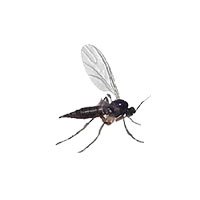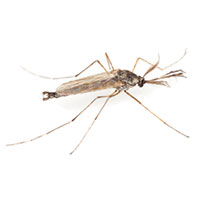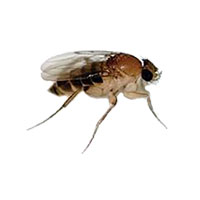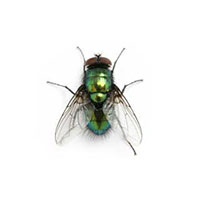Fungus Gnat Diet
Most food consumption happens during the larval stage. The larval food consists of moist, decaying organic matter and fungi growing in the soil. The adults do not eat much.
Fungus Gnat Habitat
Fungus gnats breed in various settings such as rotting wood or animal waste, under bark, or on over-watered plants. Accumulations of old mulch around buildings provide an ideal habitat. Adults are more active at dusk and are typically found near breeding sites. During the day, they will seek out dark, moist places.
Fungus Gnat Life Cycle
Eggs are deposited directly on larval food in batches of up to 30 eggs. Hatching occurs in about seven days and the larvae molt five times in about a week. Larval development is completed in two to three weeks. After pupating in the ground, adults emerge and live for about 10 days.
Fungus Gnat Control
Once a gnat problem is identified, the key to elimination is to locate and remove the breeding site. Any sites or conditions which could support fungal growth should be inspected. Once a breeding site is located, clean and dry out the area.
- Monitor soil moisture by using soil mixes with proper drainage. Also, putting a 1/4″ layer of sand on the soil surface control larvae by keeping the top layer dry.
- Use vinegar to control adults. Use a small jar filled halfway with apple cider vinegar or cheap beer with a couple of drops of dish soap added to break the surface tension. Once you’ve filled the jars, screw on the lids, and poke several holes into them large enough for fungus gnats to enter. Place these jars in areas where you are having problems with fungus gnats, and they will dive into the vinegar and drown. Strain and reuse the vinegar until you have gained control.
- Use sticky traps to control adults. Make your own sticky trap by smearing Vaseline on a 4″x 6″ piece of bright yellow card stock, and place the card horizontally just above the surface of your potting media, where it will catch the adults as they leap from the soil.
- Use insecticidal soap. The insecticidal soap’s power against fungus gnats comes from its ability to penetrate their exoskeleton. This weakens and dehydrates the fungus gnat while allowing the spray’s pyrethrin to enter the insect’s system.
Need help with Fungus Gnats?
We'll call you! Leave your information below.





